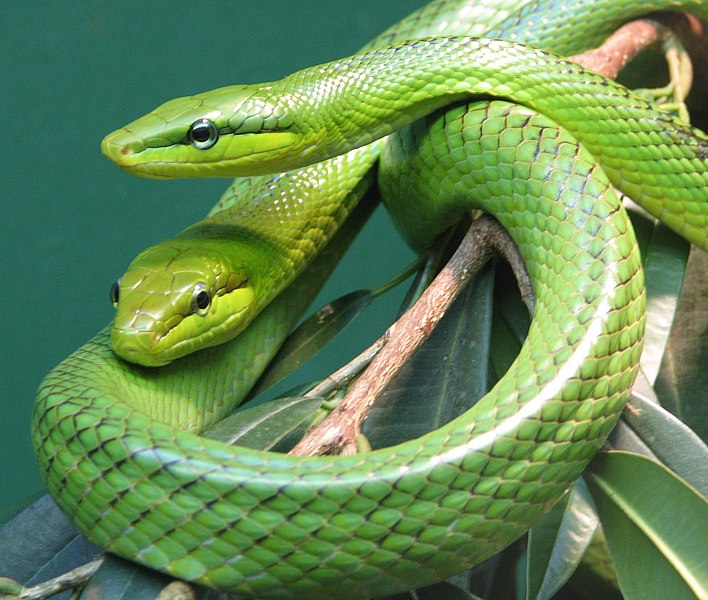 My first contact with the strikingly marked red-tailed ratsnake came many years ago, when they were rarely seen in the pet trade. It was a wild caught adult and showed up, unexpected, in an order sent to an animal importer for whom I worked at the time. She would eat only birds, which, fortunately for her, were in good supply (bird imports in those years were not well managed, and shipping-related deaths were all too common).
My first contact with the strikingly marked red-tailed ratsnake came many years ago, when they were rarely seen in the pet trade. It was a wild caught adult and showed up, unexpected, in an order sent to an animal importer for whom I worked at the time. She would eat only birds, which, fortunately for her, were in good supply (bird imports in those years were not well managed, and shipping-related deaths were all too common).
After a few months, she was so set on an avian diet that even bird-scented rodents would not pique her interest. Eventually, the snake was purchased by one of the few people who could supply her preferred diet – a hobbyist with access to inexpensive chicks from the chicken farm near his home on Long Island!
NATURAL HISTORY
Classification
Red-tailed ratsnakes are placed within the family Colubridae. They were formerly classified, along with corn, black rat and similar North American species, in the genus Elaphe.
In the pet trade, red-tailed, mandarin and bamboo rat snakes, along with Taiwan beauty snakes and similar species, are often collectively referred to as Asian or Old World ratsnakes.
Physical Description
These slenderly built snakes vary widely in color throughout their huge range, but are generally pale to emerald green, with a red or reddish tail. A yellow band of varying width separates the green and red-colored areas.
Gray and silver individuals are common in Java, and yellow specimens are known from Thailand and the Philippines. Orange and yellow/black speckled strains are being selectively-bred in the pet trade.
Red-tailed ratsnakes average 5 feet in length, with rare individuals reaching 7.5 feet. Females are generally longer and stouter than males.
Range
Red-tailed ratsnakes range widely throughout south and Southeast Asia, and occur in Myanmar, Cambodia, Indonesia, Laos, Malaysia, Thailand, Vietnam, the Philippines and on the Andaman and Nicobar Islands off India.
Habitat
Mangrove swamps, primary rainforest, bamboo forests, overgrown fields, agricultural areas, brushy areas on village outskirts and large parks.
This snake is highly arboreal, often dwelling 40 feet or more above the ground, but occasionally descends to earth in search of prey. In some areas, it is said to frequent timber and thatched-roofed dwellings.
Status in the Wild
This species’ status in the wild is largely unstudied, but they are likely threatened due to habitat loss in many areas. However, if unmolested, red-tailed ratsnakes will take up residence on farms and near houses, where they prey upon the rodents and birds that frequent these areas.
Diet
Bats, mice, rats, squirrels and other mammals, birds and their eggs, treefrogs and lizards.
Prey is killed by constriction; the tail is highly prehensile, allowing for long strikes at fast-moving, arboreal prey.
There is some evidence that, especially in young animals, the red-tipped tail is waved as a lure to attract frogs, lizards and birds to within striking range.
Reproduction
Mating occurs during the rainy season, which over much of this snake’s range falls between November and March. The eggs, 5-8 in number, are laid approximately 60 days after mating. The clutch is deposited in a sheltered, moist location, sometimes within moss and epiphytic plants among tree branches. The young hatch in 100-140 days, and are 12-18 inches in length.
Well-fed females can lay up to 4 clutches each year, an unusually large number for a snake.
Miscellaneous
The ratsnake’s color offers exceptionally good camouflage among vines and tree branches, and this is its first line of defense. However, even when there is an opportunity to flee, disturbed individuals often stand their ground.
When threatened, red-tailed ratsnakes compress and inflate the first third of the body while rearing up in an “S” shaped coil. If this display fails to intimidate the foe, they strike repeatedly.
Check back soon for an article on the captive care of the Red-tailed Ratsnake.
Image referenced from Wikipedia.
 That Reptile Blog – Reptile, Amphibian and Exotic Pet Care and Information
That Reptile Blog – Reptile, Amphibian and Exotic Pet Care and Information


